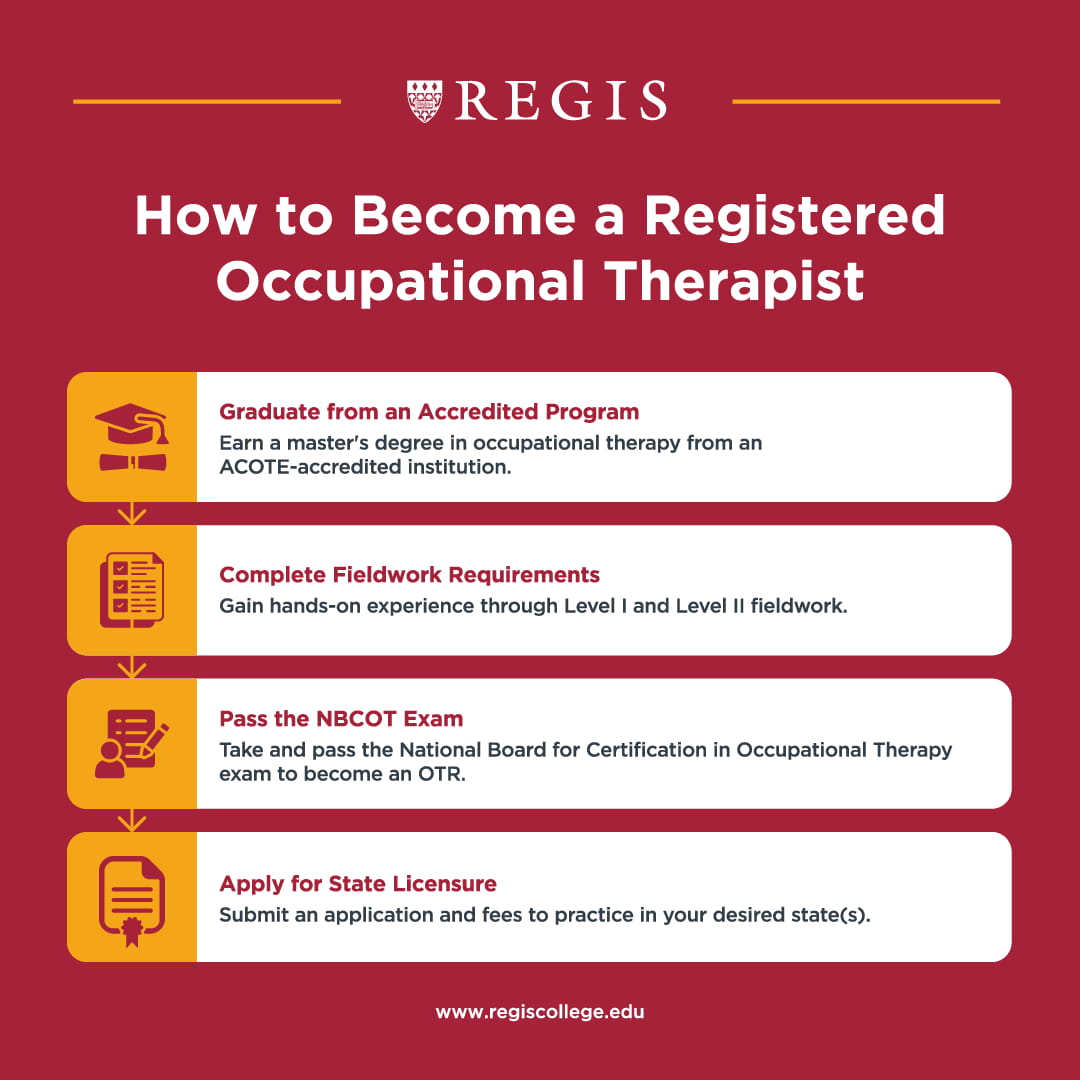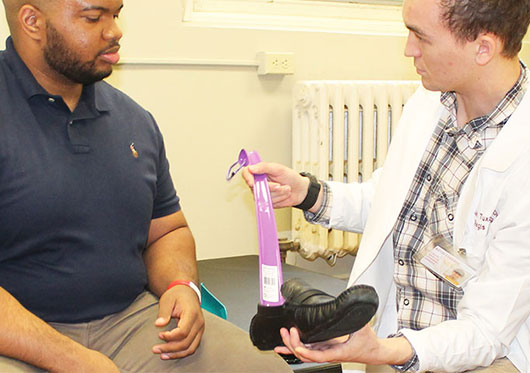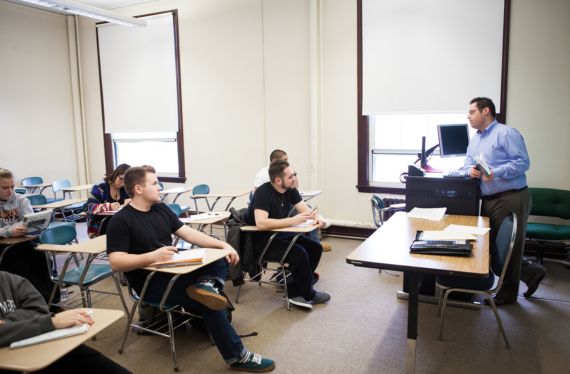Congratulations on your decision to pursue a career in occupational therapy. This rewarding profession offers strong job security, competitive salaries, and the chance to make a meaningful impact on people's lives every day. In fact, the field currently ranks #23 in the U.S. News and World Report’s Best Job List for 2025.
But now, you’re likely asking yourself more specific questions about how to become an occupational therapist. Common questions include:
- What degrees, certifications, and experience do I need?
- How do I find an academic program that suits my needs?
- What are the requirements to obtain a license in occupational therapy?
Below, we explore the steps that will be required if you wish to become a registered occupational therapist.
Key Takeaways
- A career as an occupational therapist offers a fulfilling healthcare path focused on helping individuals regain independence and improve their quality of life through therapeutic interventions.
- Occupational therapists work in diverse settings such as hospitals, schools, clinics, and community centers, providing customized treatment plans to support patients' physical, emotional, and social well-being.
- To become a licensed occupational therapist, you must earn a master’s degree from an accredited program, complete fieldwork, pass the NBCOT exam, and obtain state licensure.
- Occupational therapy programs typically take two to three years to complete and include hands-on fieldwork experience in real-world healthcare environments.
How to Become a Registered Occupational Therapist
To become a registered occupational therapist, you must: Graduate from an accredited educational program with a master's degree in occupational therapy, complete fieldwork requirements, pass your certification exam, and apply for licensure.

1. Graduate from an accredited educational program.
The first step in becoming a registered occupational therapist is to graduate with a degree from an accredited educational program.
The Accreditation Council for Occupational Therapy Education (ACOTE) ensures that educational institutions meet the minimum entry-level requirements for accreditation, including pre-requisite education, coursework, and field experience.
Ultimately, you’ll need to earn a master’s degree in occupational therapy, which typically takes two to three years to complete.
To find the right accredited program for you, thoroughly research the institutions you’re interested in. Don’t know where to start? Michael Roberts, associate professor and program director for the Master of Science in Occupational Therapy program at Regis College, suggests that you “check basic stats like length of program, number of fieldwork sites, faculty to student ratios, average class sizes for lecture and lab, job placement rates, and certification exam pass rates.”
“When checking on pass rates, be sure to also check retention rates for the program. Some programs have strong pass rates but have 80 percent retention rates, meaning the students are culled out halfway through the program,” he says.
It is also important to note that not all occupational therapy programs are the same. Many will have similar general prerequisites, however. For instance, all MS in OT programs will require you to have earned a bachelor’s degree. This undergraduate degree does not necessarily need to be in a specific field, but one related in some way to occupational therapy is typically a good idea. Many students looking to become an occupational therapist have a science- or healthcare-related background; some may even follow a pre-OT track if it is offered by their university.
Curriculum may vary widely between institutions, so it is also important to review it carefully before applying. Common coursework in most OT programs includes functional anatomy, medical and social conditions, health ethics, assistive technology, research methods, and adult and child patient care. If you would like to work with a certain patient population or treat a certain type of disorder or disability, it is important to choose a program that will offer you the ability to explore this.
2. Complete fieldwork requirements.
In conjunction with your coursework, you’ll be required to complete fieldwork at your academic institution. Fieldwork is where classroom learning comes to life. Through real-world experience, you’ll develop essential skills, gain hands-on practice, and build confidence. In order to become a registered occupational therapist, fieldwork is mandatory.
As you apply to academic programs, it’s important to learn what fieldwork opportunities are available. Fieldwork is divided into two parts: Level I and Level II. The length and type of fieldwork required for all students is set by AOTA, but each university determines the required hours to complete combined Level I and Level II fieldwork.
According to AOTA, Level I is geared toward introducing students to fieldwork experience, to apply knowledge to practice, and to develop an understanding of the needs of clients.
Your fieldwork may include experiences directly related to occupational therapy and other situations to teach students about developmental stages, tasks, and roles of individuals throughout their lifespan.
Level II, which requires students to maintain a minimum of 24 weeks of full- or part-time work, develops competent, entry-level skills. Your fieldwork must include experience in delivering occupational therapy services to clients and focus on the application of purposeful research, administration, and management of OT services.
Some fieldwork may also include administrative and service management experiences, environmental analysis experiences, and work with disabled, age-specific, or diagnosis-specific clients.
The good news is that there’s a wide range of places to complete your fieldwork, so you can gain a breadth of experience. Day care centers, schools, hospice, homeless shelters, therapeutic centers, private clinics, and mental health community centers are all common fieldwork locations. You should work closely with your academic institution to determine the criteria required for your program.
3. Pass the NBCOT exam.
The next step to licensure is to pass the National Board for Certification in Occupational Therapy (NBCOT) exam. NBCOT works to guarantee that occupational therapy practitioners across the country meet set standards by administering a national certification exam that all occupational therapists must pass. Passing the exam qualifies therapists to use the title Occupational Therapist Registered (OTR).
To qualify for the NBCOT exam, you must have obtained a Master’s degree from an accredited program and completed the required fieldwork. The exam also requires a $515 application fee, and you must have your school registrar submit your official final transcript or Academic Credential Verification Form (ACVF). Upon submitting your application, you have up to three months to take the exam.
NBCOT and AOTA offer self-study and assessment tools to help candidates prepare for examination, including practice questions and exam review courses that include intensive two-day weekend training and textbook work, but they can be pricey. No matter what resources you decide to use for studying, Roberts suggests you keep in mind that your master’s degree has trained you well.
“Between your classwork and fieldwork, you’ve essentially been studying for the exam since the first day you sat down to class in your OT program,” he says. “Remember that you have graduated from an accredited OT program taught by expert faculty and met stringent academic standards just to be able to take the exam.”
4. Apply for licensure.
Once you’ve passed the NBCOT exam, you must apply for your occupational therapy license and pay the license fee for each state or jurisdiction in which you wish to practice. Many states will allow OTs to practice on a temporary license or limited permit while waiting to take or receive results from the NBCOT exam.
Remember: it is critical to research each specific state’s requirements in which you hope to practice. Every state requires occupational therapists to be licensed before they practice. Requirements to obtain your license, however, vary by state. If you’re an aspiring therapist, you’ll want to check the state requirements where you wish to practice before applying.
Your education as an occupational therapist doesn’t stop once you earn your license, either. Most states also require occupational therapists to earn continuing education credits, roughly every two years, in order to maintain their license.
Starting Your Occupational Therapy Career
While the road to becoming an occupational therapist may seem challenging, the end result typically leads to the opportunity to drive positive change and improve people’s lives in a variety of circumstances. The bottom line? To get licensed, be sure to find an academic program and fieldwork experience that meets your needs, pass the NBCOT exam, and apply to the states in which you’d like to practice.







